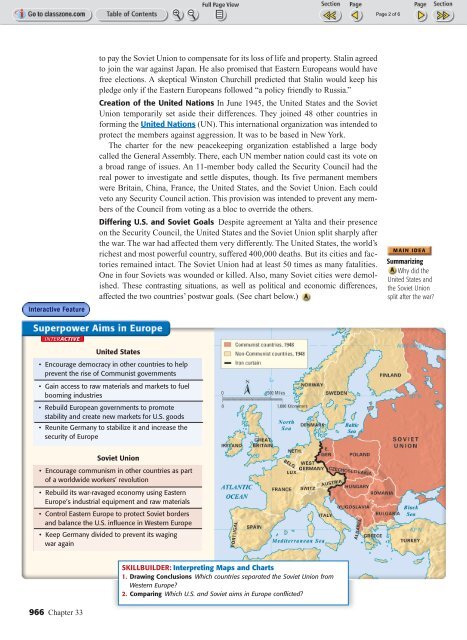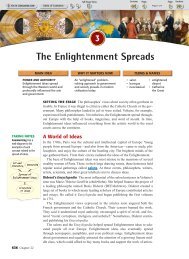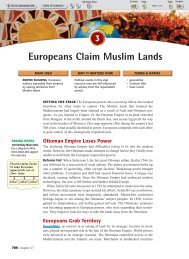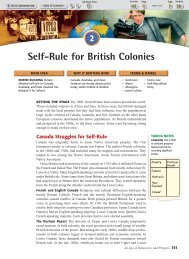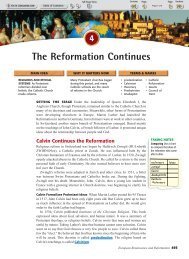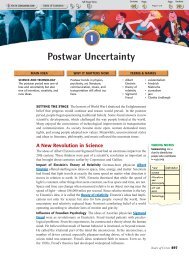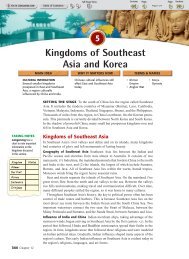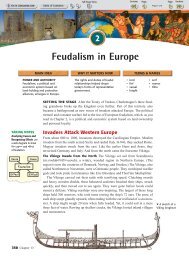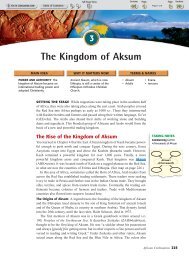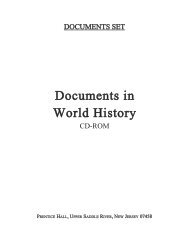Cold War: Superpowers Face Off - Mr. Trainor's Page
Cold War: Superpowers Face Off - Mr. Trainor's Page
Cold War: Superpowers Face Off - Mr. Trainor's Page
You also want an ePaper? Increase the reach of your titles
YUMPU automatically turns print PDFs into web optimized ePapers that Google loves.
to pay the Soviet Union to compensate for its loss of life and property. Stalin agreedto join the war against Japan. He also promised that Eastern Europeans would havefree elections. A skeptical Winston Churchill predicted that Stalin would keep hispledge only if the Eastern Europeans followed “a policy friendly to Russia.”Creation of the United Nations In June 1945, the United States and the SovietUnion temporarily set aside their differences. They joined 48 other countries informing the United Nations (UN). This international organization was intended toprotect the members against aggression. It was to be based in New York.The charter for the new peacekeeping organization established a large bodycalled the General Assembly. There, each UN member nation could cast its vote ona broad range of issues. An 11-member body called the Security Council had thereal power to investigate and settle disputes, though. Its five permanent memberswere Britain, China, France, the United States, and the Soviet Union. Each couldveto any Security Council action. This provision was intended to prevent any membersof the Council from voting as a bloc to override the others.Differing U.S. and Soviet Goals Despite agreement at Yalta and their presenceon the Security Council, the United States and the Soviet Union split sharply afterthe war. The war had affected them very differently. The United States, the world’srichest and most powerful country, suffered 400,000 deaths. But its cities and factoriesremained intact. The Soviet Union had at least 50 times as many fatalities.One in four Soviets was wounded or killed. Also, many Soviet cities were demolished.These contrasting situations, as well as political and economic differences,affected the two countries’ postwar goals. (See chart below.)SummarizingWhy did theUnited States andthe Soviet Unionsplit after the war?United States• Encourage democracy in other countries to helpprevent the rise of Communist governments• Gain access to raw materials and markets to fuelbooming industries• Rebuild European governments to promotestability and create new markets for U.S. goods• Reunite Germany to stabilize it and increase thesecurity of EuropeSoviet Union• Encourage communism in other countries as partof a worldwide workers’ revolution• Rebuild its war-ravaged economy using EasternEurope’s industrial equipment and raw materials• Control Eastern Europe to protect Soviet bordersand balance the U.S. influence in Western Europe• Keep Germany divided to prevent its wagingwar again966 Chapter 33SKILLBUILDER: Interpreting Maps and Charts1. Drawing Conclusions Which countries separated the Soviet Union fromWestern Europe?2. Comparing Which U.S. and Soviet aims in Europe conflicted?


